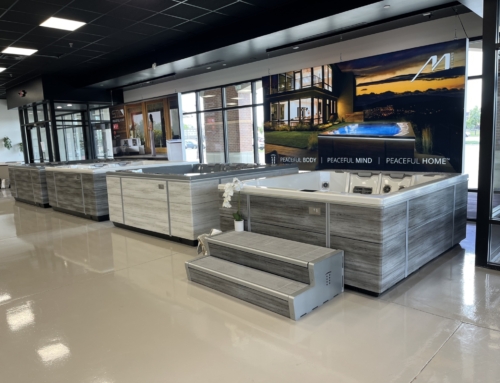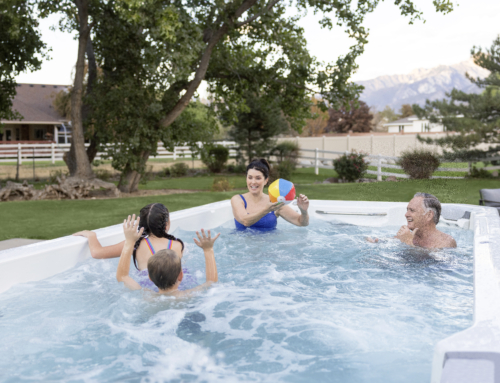It takes focus and hard work to build a successful hot tub retail business. An essential component of achieving that success is setting realistic, measurable goals.
How exactly is setting goals important for business success?
According to a Harvard study, goal setting is important for two reasons: Motivation and Achievement. This study found that setting clear, specific goals motivated people to complete tasks. Additionally, the study showed that those who followed a specific plan and monitored their goals performed 30% better than the ones who didn’t follow a plan. So, what does this mean to you?
Identifying strengths, weaknesses, opportunities and threats is the foundation for effective goal setting.
It means that having clearly defined goals and a detailed strategy for measuring progress could increase the success of your sales team and your business.
Know Where You Stand
When asked about goal-setting priorities, many experts in the spa industry emphasize the importance of knowing your strengths and weaknesses then exploiting strengths and improving weaknesses. An effective way to find out just where you stand in these areas is the SWOT method of business analysis.
- Strengths: What do you already do well?
- Weaknesses: Which areas need improvement?
- Opportunities: What new prospects can be taken advantage of?
- Threats: What dangers to your business need to be addressed?
For hot tub retailers, strengths could include knowledgeable sales staff and quality products. Weaknesses, on the other hand, could be a lack of display space or ineffective marketing strategies. Opportunities might include the potential for building expansion or the addition of a test spa, while threats might be the opening of a competitor’s store or the growth of online stores with more competitive prices.
By breaking the long-term goal into several short-term goals it becomes easier to manage and achieving smaller monthly goals motivates the team to keep working toward the annual goal.
Following a SWOT analysis, market research should be completed to show hot tub retailers where they stand in terms of trends and changes in the spa market. A clearer understanding of the market also helps them familiarize themselves with customer needs and expectations. Benchmarking to compare the income and expenses of other spa retailers can be useful as well, though this info is oftentimes difficult to access.
So, if a business is lacking in marketing techniques, adding a test spa to its facility would draw people to the business where the knowledgeable sales staff would introduce them to the quality products and services offered in the store. A good customer experience increases the likelihood they will purchase from you. And when they purchase a spa from your store, they are more likely to return for accessories and services, even if someone else offers them at lower prices.
Identifying strengths, weaknesses, opportunities and threats is the foundation for effective goal setting.
Know Your Target
Once you’ve completed a SWOT analysis, use what you’ve learned to set concrete goals. A concrete goal is specific, measurable, and obtainable.
Not Concrete: “I want to sell more hot tubs.”
Concrete: “I want to increase hot tub sales by 15% over the next three months.”
By setting a specific percentage of sales increase over a specific time period, the goal becomes measurable. Tracking sales on a daily, weekly, and monthly basis measures progress toward achieving the goal and allows you to make adjustments along the way to help you obtain the objective. By documenting and periodically reviewing concrete goals, the chances of success can increase by as much as 95%, according to Forbes.
In almost every company there is a gap between the things we say we are going to do and what we actually do. In that gap there is incredible opportunity. - Doug Fleener
Pool and Spa News recommends using Key Performance Indicators (KPI) to help achieve goals. They suggest starting small with two or three (retail sales, customer service, and spa service for instance) and analyzing them each month for one year. Afterward you may add or subtract KPIs as necessary, although they advise not to attempt more than 10-12 at a time to avoid becoming overwhelmed.
You should also keep in mind that short-term goals are easier to achieve than long-term ones, so it’s best to break larger goals into smaller increments, for instance:
Long-Term Goal: Increase annual sales by 24%
Short-Term Goal: Increase March sales by 2%
By breaking the long-term goal into several short-term goals it becomes easier to manage. And achieving smaller monthly goals motivates the team to keep working toward the annual goal.
Know Who You Know
Who can best help you achieve your business goals? The obvious answer is your employees. From every floor person to the highest level of management, all members of the team have a role to play in setting and reaching business goals. Using the following steps will help get everyone on the same page:
- Collaborative Goal Creation: Let employees help set the goals and devise strategies to achieve them
- Highlight Expectations: Show each team member how you expect them to help obtain the goal
- Monitor and Measure Progress: Regularly track the progress toward each goal, analyze what is working and what isn’t and make adjustments as needed.
When each team member has a clear map of their responsibilities and understands how their individual contribution is necessary to achieve the goal, that goal becomes more attainable. Employees tend to be more focused and organized when they see themselves as part of the overall success of the company.
When each team member has a clear map of their responsibilities and understands how their individual contribution is necessary to achieve the goal, that goal becomes more attainable.
When asked about spa retailers’ common goals, Retail Division Manager of Bullfrog Spas Factory Stores Ryan Pasley responded, “Ultimately, to improve customer experience, and at the end of the day giving people a place to feel better, have less stress, and spend quality time with loved ones.”
Just as you want to help them achieve their goals, these same customers can also help you achieve your goals. Reach out to them to see if they’re satisfied with their purchases, their in-store experience, and their follow-up services. Contact customers who did not make a purchase and find out why. Knowing your customer base can make a difference between achieving and not achieving goals.
Know the Bottom Line
In summary, goal setting boils down to three things for the hot tub retailer:
- Knowing the industry and the position of your business within it
- Knowing what you want to achieve in the long run and setting goals accordingly
- Knowing who can provide the best support and assistance in setting and achieving goals
Knowledge is the key to successfully setting and achieving business goals. Doug Fleener, president of Sixth Star Consulting in Lexington, Massachusetts says, “Get better at executing what you have learned. And that goes from the owner down to the front line employee. In almost every company there is a gap between the things we say we are going to do and what we actually do. In that gap, there is an incredible opportunity.”
Don’t let this opportunity pass you by. Fill that gap with a team meeting and set the goals that will make 2022 the most productive year yet.








Leave A Comment